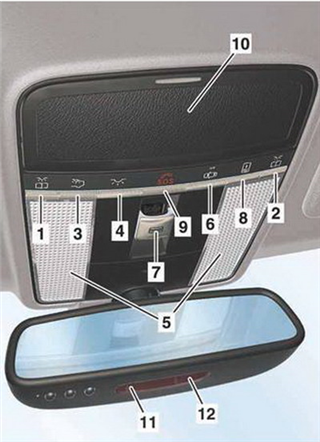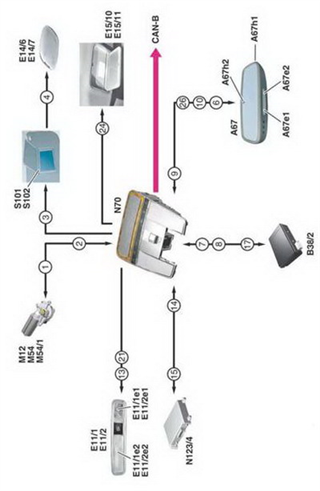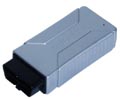- Benz 221 OverHead Panel
- |
- Benz 221 Control Units
- |
- Mercedes Electronic
- |
- Technical Info
- |
- Car Tech Info
- |
- MicroTronik
Mercedes Benz 221 OverHead Panel Control Unit
Overhead control panel
· 1 Left front reading lamp switch· 2 Right front reading lamp switch
· 3 Rear dome lamp switch
· 4 Front dome lamp switch
· 5 Front dome lamp
· 6 Door contact ON and OFF switch
· 7 Roof switch
· 8 Rear roller sun blind switch
· 9 SOS switch
· 10 Eyeglass compartment
· 11 Left reading lamp
· 12 Right reading lamp
Task
The overhead control panel control unit reads sensors and switches and controls their functions. Depending on the requests received, consumers are switched or supplied with voltage and signals are transmitted or received via CAN-B.Control
• Master control unit for interior illumination• Exit lamps
• Warning lamps
• Footwell lamps
• Ambiance illumination (instrument panel, door trim strip illumination, door inside handle illumination) (code 876)
• Tilting/sliding roof (code 414)
• Panoramic sliding roof and roller sun blinds (model 221.1 with code 413)
Special functions
• Windshield wiper startup suppression• OFF delay function of interior lights
• Rain closing feature of tilting/sliding roof (code 414)
• Memory function of tilting/sliding roof (code 414 without code 494)
• Dimming function of inside rearview mirror and driver-side outside mirror (code 249)
• Comfort lamp shutoff
• Pre-open function
Note
The special functions are not necessarily controlled by the overhead control panel, they may just be indirectly associated with the overhead control panel.
Switching consumers
• Inside rearview mirror unit• Left rear interior lamp
• Right rear interior lamp
• Roof system drive unit (code 414, model 221.1 with code 413)
• Front roller sun blind motor (model 221.1 with code 413)
• Rear roller sun blind motor (model 221.1 with code 413)
Voltage supply
• Inside rearview mirror unit• Rain/light sensor
• Left rear dome lamp
• Right rear dome lamp
• Left front vanity mirror illumination
• Right front vanity mirror illumination
• Left rear vanity mirror illumination
• Right rear vanity mirror illumination
Reading integrated switches
• Left front reading lamp switch• Right front reading lamp switch
• Rear dome lamp switch
• Front dome lamp switch
• Door contact ON and OFF switch
• Roof switch (code 414 or model 221.1 with code 413)
• Rear roller sun blind switch (model 221.1 with code 413)
Note
The SOS switch (code 494) is integrated in the overhead control panel control unit but is read discretely by the emergency call system control unit.
Reading external switches
• Left rear dome lamp switch• Right rear dome lamp switch
Reading sensors
• Rain/light sensor• Roof system Hall sensor 1
• Roof system Hall sensor 2
• Front roller sun blind Hall sensor 1
• Front roller sun blind Hall sensor 2
• Rear roller sun blind Hall sensor 1
• Rear roller sun blind Hall sensor 2
• Automatic dimming interior rearview mirror sensor, forward
• Automatic dimming interior rearview mirror sensor, back
Interface to CAN-B
• Rain/light sensor• Inside rearview mirror unit
CAN signals
The overhead control panel control unit is an interior CAN subscriber in the overall network.Left front reading lamp switch (1) and Left reading lamp (11)
Pressing the left front reading lamp switch (1) switches the left reading lamp (11) on the underside of the inside rearview mirror unit on or off.
Right front reading lamp switch (2) and Right reading lamp (12)
Pressing the right front reading lamp switch (2) switches the right reading lamp (12) on the underside of the inside rearview mirror unit on or off.
Rear dome lamp switch (3)
Pressing the rear dome lamp switch (3) switches the interior illumination in the rear on or off.
Front dome lamp switch (4) and Front dome lamp (5)
Pressing the front dome lamp switch (4) switches the left and right front dome lamp (5) in the overhead control panel on or off.
Door contact ON and OFF switch (6)
Pressing the door contact ON and OFF switch (6) activates the automatic control for the interior illumination.
The interior illumination is automatically switched on when
• The vehicle is unlocked
• A door is opened
• The transmitter key is removed from the ignition lock.
The interior illumination switches back off after a delay.
Pressing the door contact ON and OFF switch (6) again switches off the automatic control for the interior illumination.
The indicator lamp "OFF" next to the door contact ON and OFF switch (6) lights up.
Roof switch (7) or Tilting/sliding roof
Circuit 15R or circuit 15 must be switched on to actuate the tilting/sliding roof.
Pulling the roof switch (7) towards the rear up to the actuation point and holding it there opens the tilting/sliding roof for the duration of the actuation.
The tilting/sliding roof is closed by actuating the switch in the opposite direction.
Pulling the roof switch (7) towards the rear over the actuation point and briefly holding it there automatically opens the tilting/sliding roof all the way.
The tilting/sliding roof is automatically closed by actuating the switch in the opposite direction.
Pressing the roof switch (7) upwards to the actuation point and holding it there raises the tilting/sliding roof at the rear for the duration of the actuation.
The tilting/sliding roof is lowered by actuating the switch in the opposite direction.
Pressing the roof switch (7) upwards over the actuation point and briefly holding it there automatically raises the tilting/sliding roof all the way at the rear.
The tilting/sliding roof is automatically lowered by actuating the switch in the opposite direction.
The tilting/sliding roof can be stopped in any desired position during automatic operation by briefly actuating the roof switch (7) in any direction. The tilting/sliding roof stops in its current position.
Note
Vehicles without code 494 are equipped with a memory function for automatic operation i.e. the tilting/sliding roof always opens to the last open position when opened automatically. The roof switch (7) must be pulled over the actuation point for a second time to open the tilting/sliding roof all the way.
Note
The cover of the tilting/sliding roof protects against solar radiation. If the tilting/sliding roof is opened, the cover is also opened at the same time. When the tilting/sliding roof is closed or raised at the rear, the cover can only be operated by hand.
Panoramic sliding roof and front roller sun blind
Circuit 15R or circuit 15 must be switched on to actuate the panoramic sliding roof and open the front roller sun blind.
Pulling the roof switch (7) towards the rear up to the actuation point and holding it there opens the front roller sun blind for the duration of the actuation.
Pulling the roof switch (7) towards the rear over the actuation point and briefly holding it there automatically opens the front roller sun blind all the way.
The front roller sun blind can be stopped in any desired position during automatic opening by briefly actuating the roof switch (7) in any direction. The front roller sun blind stops in its current position.
The front roller sun blind is always closed by pressing the roof switch (7) to the front and holding it there until the blind is fully closed.
Pulling the roof switch (7) towards the rear up to the actuation point and holding it there opens the panoramic sliding roof for the duration of the actuation.
Pulling the roof switch (7) towards the rear over the actuation point and briefly holding it there automatically opens the panoramic sliding roof all the way.
The panoramic sliding roof can be stopped in any desired position during automatic opening by briefly actuating the roof switch (7) in any direction. The panoramic sliding roof stops in its current position.
The panoramic sliding roof is always closed by pressing the roof switch (7) to the front and holding it there until the roof is fully closed.
Pressing the roof switch (7) upwards to the actuation point and holding it there raises the panoramic sliding roof at the rear for the duration of the actuation.
The panoramic sliding roof is lowered by actuating the switch in the opposite direction.
Pressing the roof switch (7) upwards over the actuation point and briefly holding it there automatically raises the panoramic sliding roof all the way at the rear. If the front roller sun blind is still closed, it is first opened automatically and then the panoramic sliding roof is automatically raised all the way at the rear.
Note
The front roller sun blind can only be closed if the panoramic sliding roof is closed. It is not possible to close the front roller sun blind automatically.
Note
It is not possible to automatically close the panoramic sliding roof or automatically lower it at the rear.
Rear roller sun blind switch (8)
The roller sun blind at the rear can be operated from the front using the rear roller sun blind switch (8).
The rear roller sun blind is opened or closed by pressing and holding the rear roller sun blind switch (8) until the roller sun blind in the rear has reached the desired position.
Note
The roller sun blind at the rear must first be completely opened or closed before the direction of actuation can be changed.
SOS switch (9)
Pressing the SOS switch (9) transmits an emergency call manually. The indicator lamp next to the SOS switch (9) flashes to indicate that an emergency call has been activated.
Eyeglass compartment (10)
The overhead control panel is equipped with an eyeglass compartment.
The eyeglass compartment (10) is opened by pressing the silver fin.
The eyeglass compartment (10) is closed by folding it upwards until it engages.
OverHead Control Panel System connection:
· 1 Tilting/sliding roof (SHD) / panoramic sliding roof and front/rear roller sun blind OPEN/CLOSED· 2 Position of tilting/sliding roof (SHD) / panoramic sliding roof and front/rear roller sun blind
· 3 Power supply to vanity mirror illumination
· 4 Vanity mirror illumination ON/OFF
· 6 Front reading lamps ON/OFF
· 7 Rain detected
· 8 Darkness detected
· 9 Dimming information
· 10 Reverse gear engaged or interior lights switched on
· 13 Rear interior lamp ON/OFF
· 14 Emergency call active
· 15 Emergency call signal
· 17 Power supply to rain/light sensor
· 21 Power supply to rear dome lamp
· 24 Power supply to rear vanity mirror
· 26 Power supply to inside rearview mirror unit
· A67 Inside rearview mirror unit
· A67e1 Left reading lamp
· A67e2 Right reading lamp
· A67h1 Automatic dimming interior rearview mirror sensor, forward
· A67h2 Automatic dimming interior rearview mirror sensor, back
· B38/2 Rain/light sensor
· E11/1 Left rear dome lamp
· E11/2 Right rear dome lamp
· E11/1e1 Left rear reading lamp
· E11/1e2 Left rear interior lamp
· E11/2e1 Right rear reading lamp
· E11/2e2 Right rear interior lamp
· E14/6 Left front vanity mirror illumination
· E14/7 Right front vanity mirror illumination
· E15/10 Left rear vanity mirror illumination
· E15/11 Right rear vanity mirror illumination
· M12 Roof system drive unit
· M54 Front roller sun blind motor
· M54/1 Rear roller sun blind motor
· N70 Overhead control panel control unit
· N123/4 Emergency call system control unit
· S101 Left front vanity mirror illumination switch
· S102 Right front vanity mirror illumination switch
· CAN-B Interior CAN
AutoHex (Auto Diagnostic scanner) is one of the best Professional scan tools to for Mercedes Benz; Autohex Scanner can test Mercedes Benz Systems effectively and easily, with many powerful features to help you in diagnosing and testing. For more information:
Mercedes Benz Scan Tool
Changing Dmaged DME in F Series
Description
In this section we will add some useful information about some Mercedes Benz 221 OverHead Panel Control System and it features.
Autohex II Reviews
AutoHex II
AutoHex II is your best choice to have full access to dealer functions like coding, adjusting and modules flashing/programming, Contact us for prices
AutoHex Forum
AutoHex Onboard Diagnostic Forum discusses different subjects, if you want to know more about Mercedes Benz, BMW, VW, Audi, Toyota, Nissan, or other cars, join the forum now
Car Technical Information
To test a car you need a professional and technical information, the more information you have, the more easy you can find the fault
Diagnosis and Coding






